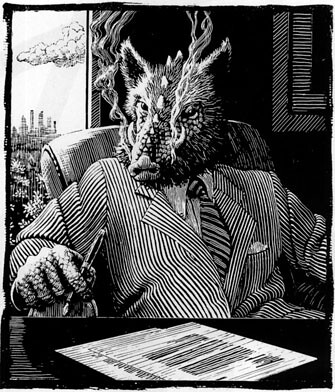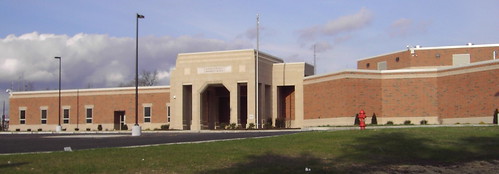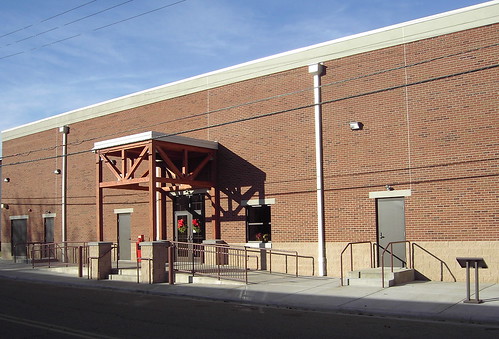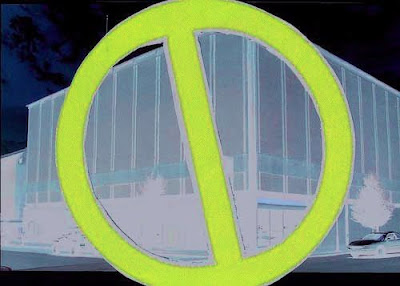
[I am reposting "Porksmouth," slightly edited, from March 2006 as background for a new article on Portsmouth Murals, Inc., which I will post soon.]
I’ve heard Republicans blame the unions for Portsmouth’s decline. I’ve heard Democrats blame the bosses. I think neither the workers nor the bosses are to blame.The fundamental reason for greater Portsmouth’s economic decline, and for the general decline of American industry in the last half century, is globalization, which is a term for economic changes that have been going on internationally for over a century but which accelerated after the Second World War. Globalization is international economic integration, or, to its critics, globalization is the internationalization of economic exploitation.
As the U.S. declined industrially as a result of globalization, those regions and sectors of the American economy most affected by the decline came to depend more and more upon the state and especially the federal government for financial assistance. Large chunks of this financial assistance were in the form of pork, which is defined on Porkopolis, a conservative pork-alert blog, as “a government project, appropriation or appointment that yields jobs or other benefits to a specific locale and patronage opportunities to its political representative.” One of the features of Porkopolis is a series on Pork in Portsmouth.
Porking Portsmouth
When did the porking of Portsmouth begin? When did Portsmouth become Porksmouth. I’m not sure, but in March 1964, the Portsmouth City Council made a momentous decision. In a resolution, numbered unlucky #13, the council turned much of the economic control of the city over to a private “non-profit” corporation named the Portsmouth Area Community Improvement Corporation (PACIC).
In Resolution #13, the Portsmouth City Council granted PACIC an extraordinarily broad mandate. The mandate of this private corporation, consisting mainly of businessmen, bankers, and lawyers, was no less than “To promote the health, safety, morals and general welfare of the inhabitants of the community . . .” In the following year, 1965, the Ohio state legislature passed a law allowing municipalities to designate community improvement corporations, such as PACIC, as their agent. As if PACIC hadn’t already been granted extraordinary power in Resolution #13, for the health, safety, morals and general welfare of the people of the Portsmouth area, the Portsmouth City Council passed another resolution, #30, designating PACIC as the city’s official agent, or legal representative.
The previous, pre-war, heavily industrialized but now depressed post-war city of Portsmouth became classified by the USDA as a “rural area,” part of the Appalachian region, thereby making it eligible for USDA pork. I was told by a native of Portsmouth, who moved back after spending most of his adult life elsewhere, that he was surprised to discover upon his return to Portsmouth that he had grown up in Appalachia. To someone growing up in Portsmouth back in the 1940s and 1950s, being Appalachian had more disadvantages than advantages, and was more likely something to be ashamed than proud of. Beginning in the 1960s, when President Johnson declared war on poverty, that situation changed. Because it was repackaged as an Appalachian community, Portsmouth qualified as underprivileged and neglected and a candidate for special government assistance. If you were Appalachian, you were assumed to be a victim of poverty, and the government was obliged, perhaps as a holdover of the Great Depression, to assist the victims of poverty as much possible.
As far as Ohio is concerned, Portsmouth is at the top of the Federal Pork Barrel. The primary governmental pork provider for Portsmouth is the U.S. Department of Agriculture (USDA). To facilitate the funneling of federal dollars into south-central Ohio, the USDA designated the Portsmouth area as the Greater Portsmouth Enterprise Community (GPEC), a kind of most-favored-pork-district classification. Apparently, no other Ohio area enjoys this distinction. I don't know whether the late Vern Riffe had anything to do with it, but Portsmouth is unique
Incidentally, when it provides relief, the US government prefers, in Orwellian fashion, to convey it in the language of entrepreneurial capitalism, in which “enterprise” is a sacred word. In urban areas there are “Enterprise zones,” in rural areas “Enterprise Communities.” Lord help those who live in neither, because the government apparently will not.
Privatizing Pork
With the creation of PACIC, in 1964, important functions of the Portsmouth city government were essentially privatized. However high-minded its original objectives might have been, PACIC and its successor, the Southern Ohio Growth Partnership, assumed the role of a private agency responsible for the acquisition and distribution of government funds. To put it bluntly, PACIC-SOGP became a pork dealer, with none of a public agency's obligation to openness. John Welton (Doug Deepe) reports that members of the SOGP are sworn to secrecy.
In this economic twilight zone of “enterprise zones” and “enterprise communities,” the only real competition is among those vying for government assistance. It is a rare “entrepreneur” in the “enterprise community” of greater Portsmouth who does not begin by asking the SOGP for some kind of federally or state financed special assistance. According to the folklore of American capitalism, in the old days entrepreneurs pulled themselves up, Horatio Alger style, by the bootstraps. Now they pull themselves up by government pork straps. Horatio Alger, Jr., incidentally, was the son of a Protestant minister who went bankrupt trying to make a killing in real estate in my home town, Revere, Massachusetts, and Horatio Alger, Jr. himself was a minister who was defrocked after sexually molesting boys in his Cape Cod parish. These are not the kind of facts that get taught in public schools, memorialized in murals, or acknowledged by the Horatio Alger Association of Distinguished Americans (HAADA).
The politically conservative HAADA gives annual awards, nicknamed “Horatio’s,” to those who have allegedly pulled themselves up by their bootstraps. Enron CEO and President Bush buddy Ken Lay was one of those awarded a “Horatio” by the HAADA. Since then Enron has collapsed and Lay has been indicted. Did the entrepreneurial “Kenny-boy” ever benefit from government favors? Did Portsmouth real estate developer Neal Hatcher ever get an abatement from the SOGP or a sweetheart dormitory deal from the local state university?
Taps for Private Piggy
 Jesse Stuart, the Kentucky author (shown left in a misleading floodwall mural), became the region's anti-pork prophet. Pork drove him to distraction and arrested his artistic development. It was downhill after his second novel, Taps for Private Tussie, a neglected classic of American literature. Hatred of pork drove Stuart further and further to the right politically until in the end he was reduced to a reactionary polemicist, romanticizing Kentucky and excoriating Ohio, extolling the land and denouncing the federal government, the satanic purveyor of pork and dependency.
Jesse Stuart, the Kentucky author (shown left in a misleading floodwall mural), became the region's anti-pork prophet. Pork drove him to distraction and arrested his artistic development. It was downhill after his second novel, Taps for Private Tussie, a neglected classic of American literature. Hatred of pork drove Stuart further and further to the right politically until in the end he was reduced to a reactionary polemicist, romanticizing Kentucky and excoriating Ohio, extolling the land and denouncing the federal government, the satanic purveyor of pork and dependency.
What Taps for Private Tussie revealed is that, in addition to fierce independence, there is a strand of dependency in Appalachian culture that is vulnerable to governmental paternalism. "The fault lies not in our government but in ourselves," is one of the unpopular ideas subtly dramatized in Stuart's novel.
Pork Zones
In its operations, the SOGP, along with the other acronym agencies that were subsequently formed, provide public feeding tubes to keep the Portsmouth area alive, even if that area appears at times, judging by the city council, to be brain-dead. We owe our soul not to the company store but to the SOGP. Since the SOGP controls the pork strings, it controls the city's purse strings, just as the Community Action agency, another creation of USDA, controls the county’s. Portsmouth may once have been a company town, and the companies may have controlled city government, but at least the companies provided jobs. Now the companies are gone and all classes in Portsmouth, under- and over-privileged, have come to depend upon government money for survival. Portsmouth’s culture of dependency is nowhere depicted on the floodwall murals, of course, because the history celebrated there is the version propagated by the Chamber of Commerce and the SOGP. The style in which the floodwall murals are painted is photographic realism, or trompe l'oeil, but the history purveyed is at best romantic and mythic and at worst Chamber of Commerce boosterism.
Maybe the SOGP and its acronymic cousins are necessary evils. The city government may not have been up to the challenge of getting and managing all the pork the city has become dependent on, especially since some of Portsmouth’s worst addicts are the over-privileged on "the Hill." In keeping with the relatively low salaries and low respect for public employees, Portsmouth city government, with a few notable exceptions, has been run by the dumb and the dishonest, by the losers and the loudmouths. We get what we don’t pay for. From Portsmouth’s first disreputable mayor, whose business was rum and pork, to Greg Bauer and our current mayor, we have had our share of bad or crab apples. Mayor George Wear, who signed off on the creation of PACIC, later hanged himself, though if there is anything to rumors surrounding his death, there might be material there for a lurid mural.
Bush Pork
Speaking of murals, I will close with the most recent example of a SOGP murals-related pork project. The 2003 Executive Report of the Greater Portsmouth Enterprise Community (GPEC) included the following statement: “SOGP is . . . the lead agency in development of the new Welcome Center.”
From start to finish, the Welcome Center has been a pork project, as were the floodwall murals that preceded it. The funds for the Welcome Center came, like so much of the pork in Portsmouth, from the USDA. Rep. Rob “Porkman” was given credit for being the Jimmie Dean sausage maker of this deal. In his campaign speech (10 Sept. 2004) at Shawnee State U., President Bush began by praising the murals and praising Portman for making the Welcome Center possible. A former economist in the Reagan administration has published a book criticizing President Bush’s economic and tax policies and pointing out that during Bush’s years in the White House, pork projects and the deficit have reached financially obscene levels. The title of the book is The Imposter, and that’s what Bush was when he praised the Welcome Center, an imposter, because the center was a dyed-in-the-rind pork project, which fiscally conservative Republicans should be scandalized by and that the president should have had the decency not to mention in mixed company.
“I want to thank my friend Rob Portman, Congressman Rob Portman,” Bush told the faithful at the Portsmouth rally. “He's a – here's typical Portman. He says, ‘Take credit for the visitors center.’ I said, ‘Wait a minute. You did all the hard lifting. All I did was see to it that it happened.’”
Like many of Bush’s unscripted elliptical-cryptical moments, this needs translating. What Bush meant is that Portman had told him not to forget to mention the Welcome Center in his speech, because it was important that Republicans and Portman and the president in particular get credit for this local pork project. The president, naturally, did not admit it was pork, anymore than the Vatican has ever admitted that the Sistine Chapel is pornography, but the cognoscenti in such situations understand what's what: here is a special gift, a pet project, a French postcard, just for you folks. Pork is one of the guilty pleasures of politics, and you disapprove of it only when it lands on somebody else's plate.
The president did say that Portman, modest (wink-wink) public servant that he is (“Here’s typical Portman”), should really be given the credit for this particular pork project. In an attempt to exorcise the hint of the school-marmish unmanliness that haunts his father's political persona, and the cheerleading draft-dodging one that haunts his own, Bush resorts to macho posturing, to walking and talking and governing in a real hombre way. [See Oliver Stone's 2008 film about Bush, W?] That's probably why Bush in referring to his buddy Portman's role in regard to the Welcome Center resorted to a masculine metaphor: “You did all the hard lifting.” If sneaking pork projects into bills is a form of weightlifting, most congressmen are Arnold Schwartzenegers.
"Lifting" has another meaning, stealing, that is appropriate in this case, because that is what the Welcome Center is, a theft from the public treasury. One of Portsmouth’s over-privileged Republican businessmen, George Clayton, had an empty department store and adjoining property in Portsmouth’s depressed downtown area. There is an unwritten law in Portsmouth that the over-privileged with distressed property must be rescued with public funds, and George Clayton was. Commercially, Clayton's property was virtually worthless, but politically, in Portsmouth's twilight-zone "enterprise community," it was worth millions.
The floodwall murals had been promoted as a way of attracting tourist dollars to Portsmouth, but when that project attracted far fewer tourists than had been forecast, it was decided that a Welcome Center was what was really needed to increase mural visitors. Originally a Kroger’s supermarket, Kenrick’s department store was turned into a box-like, unattractive Welcome Center, at a rumored cost of millions, about $400,000 of which was to pay off Clayton. In Portsmouth, buildings of architectural importance, such as the train station, are torn down, while buildings like Kenrick’s and Marting’s are treated as architectural treasures that justify the expenditure of millions of public dollars on their conversion to public buildings. The real reason they escape the bulldozing they deserve is they belong to the over-privileged who are exempted from paying the price failed businesses outside of “enterprise zones” and “enterprise communities” have to pay.
What an architect could do in the way of attractiveness and functionality was severely limited by the grocery-department store provenance of the Kenrick building. You can't make a Taj Mahal out of an outhouse. The Welcome Center should help the city council understand why the Marting building cannot be made into a suitable home for the city government. We have a new attractive state-of-the-art county jail, built from scratch. Don't visitors to Portsmouth deserve as much as the inmates of the county jail? They do, but unfortunately they are prisoners of the SOGP and Portsmouth's pork-ridden politics.

State-of-art jail: Putting inmates before tourists
Since its opening, the Welcome Center has proved to be much less tourist friendly and much more SOGP friendly than even the project’s critics had expected. The Welcome Center has been closed on weekends and holidays, when it is most likely to be of service to tourists. But the number of tourists, even in the summer, is not likely in the near future to justify the money it has taken for the creation of the murals and the conversion of a commercially worthless empty department store into a welcome center.
What the Welcome Center is useful for is as headquarters for the SOGP, which has its offices there. Like those social clubs in New York that serve as fronts for Mafia families, the Welcome Center is the front for the SOGP. The secret deals that are going to be made in the Welcome Center [such as the one that funneled $250,00 from the Ohio Cultural Facilities Commission to Portsmouth Murals, Inc.] are going to be much more important than the decisions made by the city government in the Municipal Building, which is deliberately and cynically being allowed to fall further into neglect and disrepute as a prelude to tearing it down. It is regrettable that the Municipal Building is not owned by one of the over-privileged of Porksmouth, like the Kenrick, Marting, and Adelphia buildings. If the Municipal Building was owned by one of the favored few, then it would be viewed as a Taj Mahal, and porked to the max. But it is located in Portsmouth, not Porksmouth, and owned by the people, not the over-privileged, and is occupied by the city government, not the SOGP, and that makes all the difference.

Welcome Center: Putting the pork before the cart









